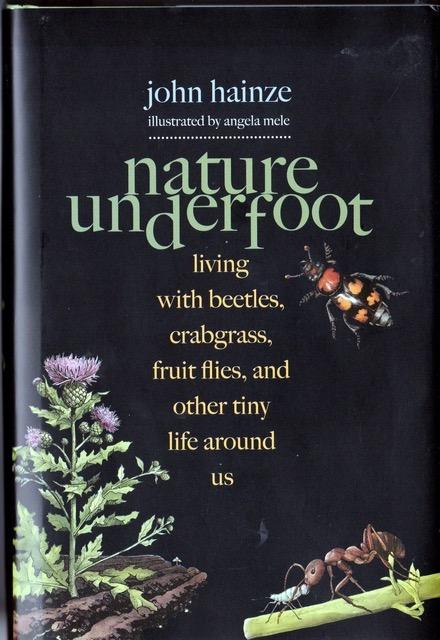John Hainze, illustrated by Angela Mele
Yale University Press
2020
ISBN: 978-0300242782
Reviewed by Peter Smithers
John Hainze writes as an insider in the pesticide industry, an industry that he worked in for many years. This book is a re-evaluation of his position in that industry, his road to Damascus, a call to find another way to coexist with the natural world, a call to respect the world that we share with so many other living organisms. It is very much a book of our time, and an examination of our relationship with the natural world at the beginning of the Anthopocene, using a selection of plants and invertebrates to illustrate the range of those relationships and setting them against the dramatic global decline of insects, and climate change.
Chapter one examines a selection of the “Anthropocene Winners”, those organisms that are flourishing in the conditions that modern man has created, for example the silverfish that thrives in our buildings along with the fruit fly Drosophila that is now almost exclusively associated with us, plus dandelions and crabgrass that have exploited the lawns that we love and have made them their own.
Chapter two, “Nature at Work”, looks at the invertebrates that offer some of the ecosystem services that maintain the biosphere. It discusses some of the bees as pollinators of our crops along with the various roles that hoverflies play, roles that range from pollination to aphid predation and the decomposition of animal remains. Millipedes are also discussed as decomposers of plant material.
In “Inadvertent Domestications”, John discusses how human environments resemble some natural habitats and looks at some of our uninvited house guests. The biology and natural history of clothes moths, bed bugs, house centipedes and dust mites are examined. “Invasions” discusses the biology and reasons for the success of invasive species, such as the creeping thistle, the Asian ladybird, the Asian tiger mosquito and garlic mustard. “The Unlucky” examines case studies of organisms that have gone extinct. It discusses the extinction and reintroduction of large blue butterfly in the UK, the loss of the Hine emerald dragonfly in the USA and the extinction and rediscovery of the low-growing shrub Franciscan manzanita in California. It then documents the drive by profit-orientated organisations to ensure that the inconvenient American burying beetle ceases to hinder development and becomes extinct.
In the chapter“Exceptionalism”, the author asks whether humans are exceptional in the biosphereby comparing them with other organisms. He examines the climate-controlled structures of termites, looks at the complex communication systems of ants and ponders the boundaries of individual organisms in light of the bacterial microbiome all animals possess. Finally, he examines the strength of dung beetles and the vital ecosystem service they provide.
In “Coexistence”, John explores the ways that voles self-regulate their populations, the complex relationship that ants and acacia have developed and discusses the chemical arms race that has evolved between the milkweed plant and the larvae of danaid butterflies. Finally, “Valuing our Anthropocene Partners” discusses human attitudes to invertebrates and plants and how various world religions have shaped man’s approach to the natural world.
Nature Underfoot is a plea from a man who found he was on the wrong side of the fence, a plea that we, as a species, alter our perspective and see the natural world in a new light. Entomologists and other naturalists will learn little that is new to them from the first five chapters, but they set the scene for the final three chapters that make for thought provoking reading. For readers who are not naturalists, the book will be a fascinating revelation of the complexities of the natural world and should persuade them to rethink their attitudes to the rest of life on Earth.
John Hainze is to be applauded for this call to arms.We have to rethink our relationship with the biosphere and this book will stir its readers to do just that. We only conserve what we know and love, and I am confident that Nature Underfoot will persuade its readers to acquire a new appreciation of the world at their feet.


